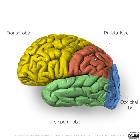Parietallappen
The parietal lobe is one of the four lobes of the brain (along with the frontal lobe, temporal lobe, and occipital lobe), located between the frontal and occipital lobes and underlying the parietal bone. It occupies about 19% of the cerebral hemispheres volume.
Gross anatomy
The parietal lobe accounts for only 19% of the total neocortical volume, only marginally larger than the occipital lobe. The lobe extends from the central sulcus anteriorly, which separates it from the frontal lobe, to the parieto-occipital fissure posteriorly, which separates it from the occipital lobe. The lateral sulcus corresponds to its inferolateral boundary, separating it from the temporal lobe. Medially, it is confined by the medial longitudinal fissure which divides both cerebral hemispheres.
Sulci and gyri
- lateral surface
- postcentral gyrus (primary sensory area)
- superior parietal lobule
- inferior parietal lobule (Wernicke's area)
- medial surface
Relations
- anterior: frontal lobe
- posterior: occipital lobe
- superior: parietal bone
- inferior: temporal lobe
Blood supply
- middle cerebral artery (MCA)
- anterior cerebral artery (ACA): medial parietal lobe
- posterior cerebral artery (PCA): posterior medial parietal lobe
Neurological deficits
The following neurological deficits occur with unilateral or bilateral lesions of the parietal lobes :
- deficits arising from unilateral lesions involving the dominant hemisphere:
- Gerstmann syndrome: right-left disorientation, finger agnosia, agraphia (without alexia), acalculia
- contralateral hemianopia
- sensory loss
- contralateral neglect (less common than non-dominant)
- bilateral astereognosis: inability to identify an object by touch alone
- deficits arising from unilateral lesions involving the non-dominant hemisphere:
- contralateral sensory loss
- contralateral neglect
- contralateral hemianopia
- topographic memory loss
- anosognosia: impaired self-awareness
- dressing apraxia
- irritative lesions involving either lobe can give rise to the following:
- simple partial seizures involving the contralateral limb
- Jacksonian march: sensory seizures spreading up/down the sensory strip (begins on one side; may begin with thumb/fingers and spread to the wrist, forearm, arm, face and leg; Todd's paresis may ensue)
Siehe auch:
und weiter:

 Assoziationen und Differentialdiagnosen zu Parietallappen:
Assoziationen und Differentialdiagnosen zu Parietallappen:

